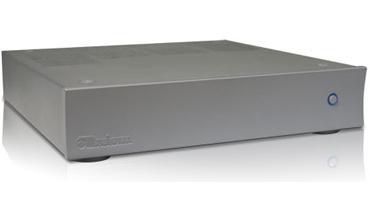Axiom Audio A1400-8

Key Features |
| $3,850 Axiomaudio.com |
| • 8-channel amplifier • 350 watts per-channel (1 channel into 8 ohms) • 200 watts perchannel (7 channels driven, all impedances) • 4 x 18 x 17[1/2] in; 54 lb |
Power amplifiers have traditionally been big, heavy beasts - especially multichannel models, which pack five or more amp modules into a single chassis. New Class D designs break with this tradition, offering equivalent power to conventional Class AB amps but in a compact and lightweight package. They pull this off by being far more efficient than Class AB designs, which typically dissipate half the power they consume from your wall outlet as waste heat - the main reason for those skin-shredding metal heatsinks found on the outside of many high-end models. But in a Class D amp, 90% or more of the current consumption goes toward powering your speakers.
The basis for the efficiency of Class D designs is the pulse-width modulation (PWM) scheme they use to allocate power. With a Class AB amp, the current flows continually from the amp's power supply to its output transistors - the tap is turned on all the time. In contrast, the output transistors on Class D models are controlled by a high-frequency carrier (a pulsewave) that switches them on and off at a steady frequency as many as four hundred thousand times per second, but with a duty cycle ("on-time") that tracks the incoming audio signal. That high-frequency carrier, which reflects in the amp's speaker outputs, resides well outside the audio band, but it's still something you don't want traveling to your speakers. So amp designers add a high-power low-pass filter at the outputs to remove residual switching artifacts, leaving just the portion of the signal you want to hear intact.
The reason why I'm sounding off here about Class D amps is that Axiom Audio, the company responsible for the S+V Certified and Recommended Epic 80/500 HT speaker system, now makes them. Axiom's A1400-8 ($3,850) packs 8 channels into a relatively compact and, given its channel count and total power output (which we'll talk more about in a moment), comparatively lightweight 54-pound chassis.
Much of the 1400-8's mass comes from its power supply. With a large toroidal power transformer and capacious capacitors, this is the type that you'd typically encounter in a high-power Class AB design. Axiom's combination of new and traditional approaches in the 1400-8 culminates in an amp that's rated to deliver up to 350 watts per channel (measured using the standard method of 1 channel continuous and the rest at [1/8] power). Its design is also meant to spread that power to any specific channel that needs it on a moment-by-moment basis, the idea being to virtually eliminate any clipping effects that can compress dynamic peaks in multichannel music or movie soundtracks when played at or above "reference-level" volume.
Physically, the 1400-8 is an interesting specimen. The amp's squat, machined-aluminum case reminds me of Apple's "unibody" MacBook Pro laptops, which basically look like seamless metal slabs. The amp is available in both black and the silver finish of my review sample. Feature-wise, the landscape here is pretty barren. A lone power button occupies the 1400-8's front panel, while around back there's a set of 8 balanced input connections, a minijack trigger input for remote-power up, and 8 pairs of high-quality 5-way speaker outputs.
SETUP
While the 1400-8 is amazingly compact for a powerful 8-channel amp, its low-riding profile made setup somewhat challenging. The speaker outputs running along the back panel's bottom half proved difficult to access when connecting cables. Someone at Axiom somewhere along the line also made the odd decision to put the AC power connection on the amp's bottom. With the 1400-8 situated on the bottom shelf of my TV stand alongside a preamp/processor, getting that power cord plugged in was rough going - it involved lifting the amp up with one hand while trying to work the cord into the socket. (Fortunately, setup is something you usually only have to do once.) To connect to my preamp/processor, I used the supplied RCA-to-[1/4]-inch plug adapters, which let me tap the preamp's unbalanced outputs for hookup.
- Log in or register to post comments




















































